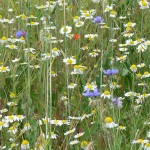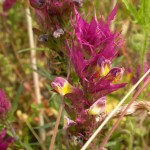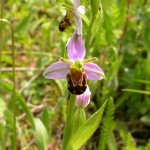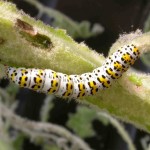13 members gathered in hot sunshine on Saturday 26th June at College Lake near Tring, a reserve of the Berkshire, Buckinghamshire and Oxfordshire Wildlife Trust (BBOWT). The entrance to the reserve is through the new visitor centre, which looks out across the lake. A preliminary search of the water’s edge revealed Lapwings and an Oystercatcher and a pair of Redshanks was seen later in the day. Almost immediately, the first of many Bee Orchids was found beside the path, with the lacy white flowers of Dropwort nearby. The leaves of a group of Mullein plants were showing feeding damage by the distinctive pale blue, yellow and black caterpillars of the Mullein moth.
Two fields at the reserve contain a superb collection of arable weeds. Each year, one is cultivated while the other is left fallow. The fallow field was alive with insects, including Marbled White, Small Heath and Common Blue butterflies, and Narrow-bordered 5-Spot and 6-Spot Burnet Moths. The cultivated field had a wheat crop which was dotted with stunning deep blue Cornflowers and scarlet poppies. Closer inspection revealed pink Corncockle, deep red Pheasant’s-eye, the tiny purple flowers of Venus’s-looking-glass and the purple heads of Field Cow-wheat. A small white umbellifer was keyed out as Knotted Hedge-parsley and Shepherd’s-needle and Thorow-wax were also found.
The group then continued further round the reserve, with abundant Pyramidal Orchids and Common Spotted-orchids beside the path. A picnic lunch was enjoyed in the shade of a small wood amongst the seed spikes of White Helleborines. Afterwards, some members carried on round the lake, while others returned along a lower path, closer to the water’s edge. The pale yellow flowers of Dragon’s-teeth were discovered next to the path down to one of the bird hides. Cold drinks and ice creams in the new visitor centre were very welcome at the end of a hot walk.
Pictures by Ricki Bull, Laurie Haseler and Jan Haseler
RDNHS day trip to College Lake on Saturday 26th June 2010
Plants near the Visitors’ Centre and along the path east of the lake:
| Plant species | English name |
| Conium maculatum | Hemlock |
| Sambucus nigra | Elder |
| Dipsacus fullonum | Teasel |
| Hypericum perforatum | Perforate St John’s-wort |
| Linum catharticum | Fairy flax |
| Prunella vulgaris | Selfheal |
| Lotus corniculatus | Common bird’s-foot trefoil |
| Silene alba | White campion |
| Carduus acanthoides | Welted thistle |
| Ophrys apifera | Bee orchid |
| Plantago lanceolata | Ribwort plantain |
| Stachys sylvatica | Hedge Woundwort |
| Senecio jacobaea | Common Ragwort |
| Senecio erucifolius | Hoary ragwort |
| Potentilla reptans | Creeping Cinquefoil |
| Veronica arvensis | Wall speedwell |
| Galium verum | Lady’s bedstraw |
| Melilotus officinalis | Ribbed melilot |
| Filipendula vulgare | Dropwort |
| Dactylorhiza fuchsii | Common spotted orchid |
| Anacamptis pyramidalis | Pyramidal orchid |
| Fragaria vesca | Wild strawberry |
| Blackstonia perfoliata | Yellow-wort |
| Agrimonia eupatoria | Agrimony |
| Plantago media | Hoary plantain |
| Leontodon hispidus | Rough hawkbit |
| Tragopogon pratensis | Goat’s-beard |
| Hieracium pilosella | Mouse-ear Hawkweed |
| Veronica chamaedrys | Germander speedwell |
| Glechoma hederacea | Ground-ivy |
| Bryonia dioica | White bryony |
| Geum urbanum | Wood avens |
| Euonymus europaeus | Spindle |
| Centaurium erythraea | Common centaury |
| Anagallis arvensis | Scarlet pimpernel |
| Sherardia arvensis | Field madder |
| Reseda luteola | Weld |
| Verbascum thapsus | Great mullein |
| Echium vulgare | Viper’s bugloss |
| Marrubium vulgare | White horehound |
| Silene dioica | Red campion |
| Alchemilla vulgaris agg. (introduced) | Lady’s mantle |
| Pentaglottis sempervirens (introduced) | Green alkanet |
| Silene vulgaris | Bladder campion |
| Convolvulus arvensis | Field bindweed |
| Ranunculus lingua (introduced) | Greater spearwort |
| Lemna trisulca | Ivy-leaved duckweed |
| Filipendula ulmaria | Meadow sweet |
| Scrophularia auriculata | Water figwort |
| Lysimachia nummularia (introduced?) | Creeping Jenny |
| Caltha palustris (in fruit) | Marsh-marigold |
| Mentha aquatica | Watermint |
| Lycopus europaeus | Gipsywort |
| Lotus uliginosus | Greater bird’s-foot trefoil |
| Digitalis ?lutea (introduced) | Small yellow foxglove |
| Medicago lupulina | Black medick |
| Agrostemma githago | Corncockle |
| Trifolium campestre | Hop trefoil |
| Geranium dissectum | Cut-leaved crane’s-bill |
| Anthyllis vulneraria | Kidney vetch |
| Primula veris (in fruit) | Cowslip |
| Origanum vulgare | Marjoram |
| Pastinaca sativa | Wild parsnip |
| Euphrasia officinalis | Eyebright |
| Torilis japonica | Upright hedge-parsley |
| Paris quadrifolia (leaves only) | Herb-Paris |
| Cephalanthera damasonium | White helleborine |
| Tussilago farara (leaves only) | Coltsfoot |
| Typha latifolia | Bulrush |
| Sedum acre | Biting stonecrop |
| Listera ovata | Twayblade |
| Tetragonolobus maritima | Dragon’s teeth |
Agricultural weeds and other plant species in wheat field (rare species in bold:)
| Species | English name |
| Melilotus altissima | Tall melilot |
| Picris echioides | Bristly oxtongue |
| Melampyrum arvense | Field cow-wheat |
| Orobanche minor | Common broomrape |
| Vicia hirsuta | Hairy tare |
| Daucus carota | Wild carrot |
| Odontites verna | Red bartsia |
| Knautia arvensis | Field scabious |
| Anthemis arvensis | Corn chamomile |
| Euphorbia helioscopia | Sun spurge |
| Myosotis arvensis | Field forget-me-not |
| Centaurea scabiosa | Greater knapweed |
| Rhinanthus minor | Yellow rattle |
| Scandix pecten-veneris | Shepherd’s needle |
| Centaurea cyanus | Cornflower |
| Iberis amara | Wild candytuft |
| Torilis nodosa | Knotted hedge-parsley |
| Bupleurum rotundifolium | Thorow wax |
| Adonis annua | Pheasant’s-eye |
| Legousia hybrida | Venus’s-looking-glass |
| Lithospermum arvense | Field gromwell |
| Aphanes arvensis | Parsley-piert |
| Diplotaxis muralis | Annual wall-rocket |
| Ranunculus arvensis | Corn buttercup |
| Viola arvensis | Field parsley |
Butterflies
Small Skipper
Large Skipper
Common Blue
Marbled White
Ringlet
Meadow Brown
Small Heath
Moths
Mullein Moth (larvae)
Cinnabar (larvae)
Narrow-bordered 5-Spot Burnet
6-Spot Burnet
List compiled by Dr Renee Grayer






